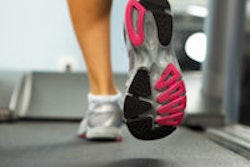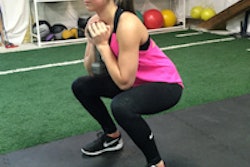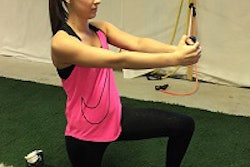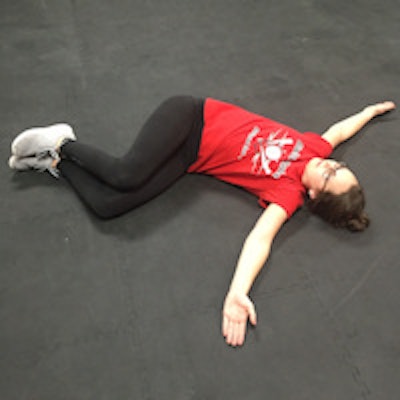
In the second part of our seven-article series on back pain in sonographers, we'll examine how posture can cause problems that affect our back and increase the chances of pain. And we're not just talking about "sitting up straight" like your mom used to tell you to do.
Following up on our first article, which focused on issues related to respiration and the core, we'll provide some simple tips and movements you can try at work or at home to improve posture and help eliminate back pain.
What causes back pain?
Back pain can be caused by poor postural stability in any part of the body or by some type of dysfunction in the joints, including ankle instability, knee instability or sprain, loss of mobility in the hip area, and even shoulder instability or lack of mobility. In our first article, we discussed upper-crossed syndrome, which demonstrates how our body works as a unit in an "X" or cross pattern. What happens in one region -- even when that area is away from the problem area -- can be the cause of your back pain.
Think about someone with a bad ankle. When the ankle is injured, the gluteus maximus muscles shut off so the ankle can heal. It has been shown in studies that when the ankle is injured, a significant delay occurs in the activation of the gluteus maximus on the injured side. This delay changes the walking pattern, which can cause a shift in the hip; that transfers or shows up as back pain.
In many cases of back pain, we treat the problem by stretching the back, doing exercises to help strengthen our core, and being safe in how we bend and rotate. In this situation, though, we should be looking at the ankle for the fix.
When it comes to back pain, pelvic tilt is frequently a postural problem that can lead to back issues. People typically fall into two categories of back pain: those who have extension-based pain or those who have flexion-based pain.
A person who has extension-based pain typically experiences worse symptoms when standing, as they have short, tight hip flexors and poor glute function, and they lack anterior core stability. Meanwhile, a person who has flexion-based back pain has more discomfort when sitting. This is because they have poor psoas function and tend to have a flatter back, which can increase the stress on the posterior ligaments of the spine and cause disk problems.
Here are our favorite movements to help you develop proper posture. If these don't help you find relief, contact us so we can help you eliminate back pain.
Lying thoracic spine rotation
Lie on the ground on your side, with your arms extended straight out at chest level and your knees pulled up toward your chest. The hips and knees should both be at 90°; also work to have your ankles at 90°. You can be on a mat, and you might want to put your head on a pillow or rolled-up mat for additional support.
To perform the exercise, keeping the knees together (if this is difficult, place a rolled-up towel or small ball between the knees), move your top arm over your body and toward the floor on the opposite side. The goal here is to get the arm and shoulder blade on the ground, not just the hand.
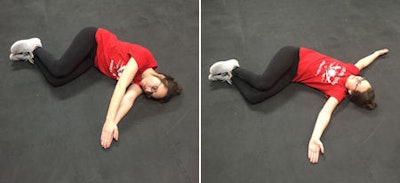 All images courtesy of Doug Wuebben.
All images courtesy of Doug Wuebben.Do two sets of eight reps on each side. Coaching tip: Movement should be through the thoracic spine -- not just the shoulder area.
Kneeling thoracic spine rotation
Once you have mastered lying thoracic spine rotation, you can progress to the kneeling thoracic spine rotation exercise. This one is a bit more advanced, requiring more control over your posture, movement, and stability.
Start in a six-point (some call it a four-point) position, on your hands and knees. Then take one hand and place it on the base of the skull behind your head. Work to keep weight evenly distributed between the legs and other arm.
Keeping the arm locked into position, point the elbow toward the ground. Keep in mind the movement should come through the back/spine -- and not just the shoulder! Rotate the torso through the spine so that the elbow is pointed up toward the ceiling, or take the movement through as much range of motion as possible. Again, be sure that movement is from the thoracic spine and not the shoulder or hips.
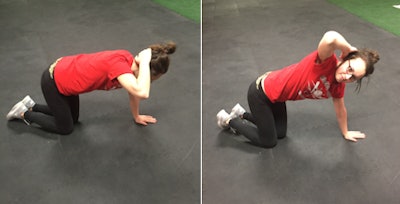
Do two sets of eight reps on each side.
Psoas lunge
Many people will do lunges by pushing the hips forward to stretch what they feel are the hip flexors and the psoas. The iliacus crossing the hip is stretched in the traditional lunge, but the psoas also crosses the hip as well as all lumbar joints.
The psoas can only be stretched when isolated with a lunge that includes lateral bending of the spine with some twisting and extension motion. This can be used as a great warm-up before running or doing any lower body work. Stretch and hold for 20 to 30 seconds and repeat several times, going in both directions.
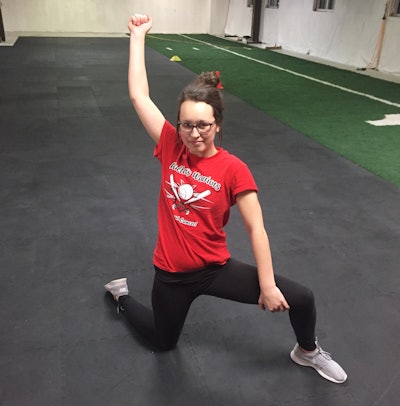
Farmer's walk
To do the farmer's walk exercise, pick up one or two dumbbells and hold them by your sides. Walk around your training area for a certain distance (start by walking 25 yards) or amount of time (start with 30 seconds). We like to have the folks we work with progress to using only one dumbbell as soon as possible, maintaining good upright form while walking.

You can also perform the farmer's walk by carrying kettlebells or any other heavy object. This is a great leg-strengthening exercise, working your calves, quadriceps, and hamstrings. It also works the muscles of the core that help support your spine and creates intra-abdominal pressure to prevent your spine from collapsing.
For variation, you can hold the weights overhead, use only one weight, or hold one weight overhead and one at your side.
In the next part of our series, we'll review issues associated with limited thoracic mobility.
Doug Wuebben is a registered echocardiographer and also a consultant, international presenter, and author of e-books in the areas of ergonomics, exercise and pain, and injury correction for sonographers. He has also been published on the topics of telemedicine and achieving lab accreditation.
Mark Roozen is a certified strength and conditioning specialist, a certified personal trainer, and a fellow of the National Strength and Conditioning Association (NSCA). He also consults, presents, writes, and works with groups, teams, and organizations around the world. He has been in the strength, conditioning, and performance field for over 30 years.
Wuebben and Roozen are co-founders of Live Pain Free -- The Right Moves. Email [email protected] or go to coachrozy.com for more information on programs, training, or speaking requests, or if you have any questions or comments.
The comments and observations expressed do not necessarily reflect the opinions of AuntMinnie.com.





